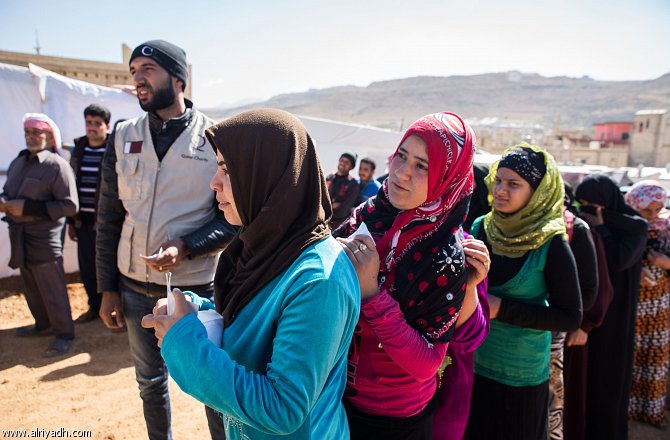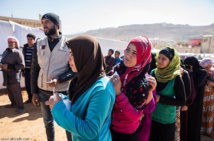The town lies on the highway that leads from eastern Deir Ezzor province, an IS stronghold, to the ancient town of Palmyra.
Palmyra is controlled by the regime and home to spectacular Greco-Roman ruins that are listed as a World Heritage site by UNESCO.
"The Islamic State managed to advance in Al-Sukhnah and take control of large parts of the town and the surrounding areas," the Britain-based Observatory said, adding that clashes were continuing Wednesday.
The group said at least 28 regime forces -- soldiers and pro-government militants -- and 20 IS fighters had been killed in the battles.
More than 100 fighters from the two sides were wounded, the monitor said.
Control of Homs province is divided. The provincial capital is almost completely under regime control, but opposition forces and IS hold large parts of the surrounding countryside and desert.
IS has a significant presence in the desert region in the east of the province bordering Deir Ezzor, which is a stronghold of the jihadist group and forms part of its self-proclaimed Islamic "caliphate" in Syria and Iraq.
Homs is Syria's largest province and is particularly important for the government as it also neighbours Damascus province.
It is home to the key Shaar gas field, which is now back in government hands after IS fighters overran it last year, reportedly slaughtering several hundred soldiers there.
Syrian regime troops and allied fighters from Lebanon's Shiite movement Hezbollah meanwhile captured the highest point in the mountainous Qalamun region, a Syrian source on the ground said.
Pro-government forces have been battling rebel groups and Al-Qaeda affiliate Al-Nusra Front in Qalamun, which lies north of Damascus and runs along the Lebanese border.
"Syrian forces and (Hezbollah) resistance fighters took full control of the strategic Tallet Moussa in Qalamun," the source said.
The peak provides a line of sight over the border area.
Syrian state television said "army forces in cooperation with the Lebanese resistance (Hezbollah) pursued the remnants of terrorist forces in the Tallet Moussa area."
The Observatory said 18 Hezbollah fighters, 31 pro-regime troops and 36 rebels had died since battles restarted in Qalamun on May 4.
In April 2014, regime and Hezbollah fighters took control of most of Qalamun, but hundreds of rebel fighters remain entrenched in the mountainous region.
Jihadists have also launched attacks inside Lebanon from bases in the area, and Hezbollah chief Hassan Nasrallah said last week that the situation there required "radical treatment".
-----------------------------------------------------------------------------------------------------------------
Palmyra is controlled by the regime and home to spectacular Greco-Roman ruins that are listed as a World Heritage site by UNESCO.
"The Islamic State managed to advance in Al-Sukhnah and take control of large parts of the town and the surrounding areas," the Britain-based Observatory said, adding that clashes were continuing Wednesday.
The group said at least 28 regime forces -- soldiers and pro-government militants -- and 20 IS fighters had been killed in the battles.
More than 100 fighters from the two sides were wounded, the monitor said.
Control of Homs province is divided. The provincial capital is almost completely under regime control, but opposition forces and IS hold large parts of the surrounding countryside and desert.
IS has a significant presence in the desert region in the east of the province bordering Deir Ezzor, which is a stronghold of the jihadist group and forms part of its self-proclaimed Islamic "caliphate" in Syria and Iraq.
Homs is Syria's largest province and is particularly important for the government as it also neighbours Damascus province.
It is home to the key Shaar gas field, which is now back in government hands after IS fighters overran it last year, reportedly slaughtering several hundred soldiers there.
Syrian regime troops and allied fighters from Lebanon's Shiite movement Hezbollah meanwhile captured the highest point in the mountainous Qalamun region, a Syrian source on the ground said.
Pro-government forces have been battling rebel groups and Al-Qaeda affiliate Al-Nusra Front in Qalamun, which lies north of Damascus and runs along the Lebanese border.
"Syrian forces and (Hezbollah) resistance fighters took full control of the strategic Tallet Moussa in Qalamun," the source said.
The peak provides a line of sight over the border area.
Syrian state television said "army forces in cooperation with the Lebanese resistance (Hezbollah) pursued the remnants of terrorist forces in the Tallet Moussa area."
The Observatory said 18 Hezbollah fighters, 31 pro-regime troops and 36 rebels had died since battles restarted in Qalamun on May 4.
In April 2014, regime and Hezbollah fighters took control of most of Qalamun, but hundreds of rebel fighters remain entrenched in the mountainous region.
Jihadists have also launched attacks inside Lebanon from bases in the area, and Hezbollah chief Hassan Nasrallah said last week that the situation there required "radical treatment".
-----------------------------------------------------------------------------------------------------------------









 Home
Home Politics
Politics











